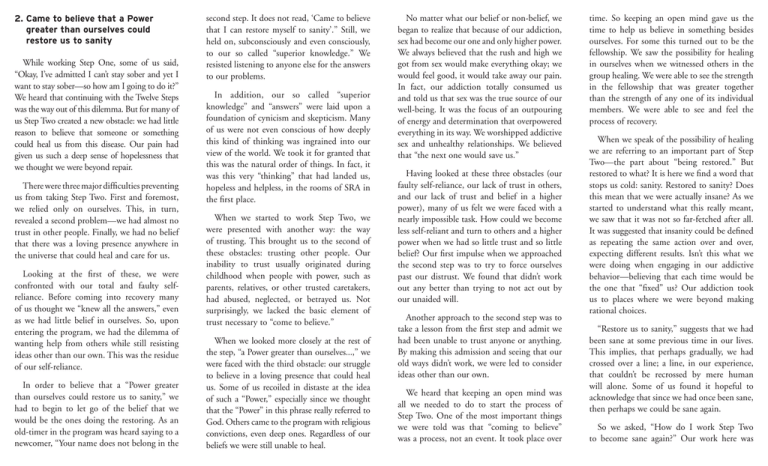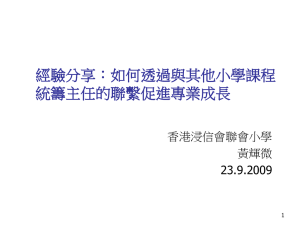
2. C
ame to believe that a Power
greater than ourselves could
restore us to sanity
While working Step One, some of us said,
“Okay, I’ve admitted I can’t stay sober and yet I
want to stay sober—so how am I going to do it?”
We heard that continuing with the Twelve Steps
was the way out of this dilemma. But for many of
us Step Two created a new obstacle: we had little
reason to believe that someone or something
could heal us from this disease. Our pain had
given us such a deep sense of hopelessness that
we thought we were beyond repair.
There were three major difficulties preventing
us from taking Step Two. First and foremost,
we relied only on ourselves. This, in turn,
revealed a second problem—we had almost no
trust in other people. Finally, we had no belief
that there was a loving presence anywhere in
the universe that could heal and care for us.
Looking at the first of these, we were
confronted with our total and faulty selfreliance. Before coming into recovery many
of us thought we “knew all the answers,” even
as we had little belief in ourselves. So, upon
entering the program, we had the dilemma of
wanting help from others while still resisting
ideas other than our own. This was the residue
of our self-reliance.
In order to believe that a “Power greater
than ourselves could restore us to sanity,” we
had to begin to let go of the belief that we
would be the ones doing the restoring. As an
old-timer in the program was heard saying to a
newcomer, “Your name does not belong in the
second step. It does not read, ‘Came to believe
that I can restore myself to sanity’.” Still, we
held on, subconsciously and even consciously,
to our so called “superior knowledge.” We
resisted listening to anyone else for the answers
to our problems.
In addition, our so called “superior
knowledge” and “answers” were laid upon a
foundation of cynicism and skepticism. Many
of us were not even conscious of how deeply
this kind of thinking was ingrained into our
view of the world. We took it for granted that
this was the natural order of things. In fact, it
was this very “thinking” that had landed us,
hopeless and helpless, in the rooms of SRA in
the first place.
When we started to work Step Two, we
were presented with another way: the way
of trusting. This brought us to the second of
these obstacles: trusting other people. Our
inability to trust usually originated during
childhood when people with power, such as
parents, relatives, or other trusted caretakers,
had abused, neglected, or betrayed us. Not
surprisingly, we lacked the basic element of
trust necessary to “come to believe.”
When we looked more closely at the rest of
the step, “a Power greater than ourselves...,” we
were faced with the third obstacle: our struggle
to believe in a loving presence that could heal
us. Some of us recoiled in distaste at the idea
of such a “Power,” especially since we thought
that the “Power” in this phrase really referred to
God. Others came to the program with religious
convictions, even deep ones. Regardless of our
beliefs we were still unable to heal.
No matter what our belief or non-belief, we
began to realize that because of our addiction,
sex had become our one and only higher power.
We always believed that the rush and high we
got from sex would make everything okay; we
would feel good, it would take away our pain.
In fact, our addiction totally consumed us
and told us that sex was the true source of our
well-being. It was the focus of an outpouring
of energy and determination that overpowered
everything in its way. We worshipped addictive
sex and unhealthy relationships. We believed
that “the next one would save us.”
Having looked at these three obstacles (our
faulty self-reliance, our lack of trust in others,
and our lack of trust and belief in a higher
power), many of us felt we were faced with a
nearly impossible task. How could we become
less self-reliant and turn to others and a higher
power when we had so little trust and so little
belief? Our first impulse when we approached
the second step was to try to force ourselves
past our distrust. We found that didn’t work
out any better than trying to not act out by
our unaided will.
Another approach to the second step was to
take a lesson from the first step and admit we
had been unable to trust anyone or anything.
By making this admission and seeing that our
old ways didn’t work, we were led to consider
ideas other than our own.
We heard that keeping an open mind was
all we needed to do to start the process of
Step Two. One of the most important things
we were told was that “coming to believe”
was a process, not an event. It took place over
time. So keeping an open mind gave us the
time to help us believe in something besides
ourselves. For some this turned out to be the
fellowship. We saw the possibility for healing
in ourselves when we witnessed others in the
group healing. We were able to see the strength
in the fellowship that was greater together
than the strength of any one of its individual
members. We were able to see and feel the
process of recovery.
When we speak of the possibility of healing
we are referring to an important part of Step
Two—the part about “being restored.” But
restored to what? It is here we find a word that
stops us cold: sanity. Restored to sanity? Does
this mean that we were actually insane? As we
started to understand what this really meant,
we saw that it was not so far-fetched after all.
It was suggested that insanity could be defined
as repeating the same action over and over,
expecting different results. Isn’t this what we
were doing when engaging in our addictive
behavior—believing that each time would be
the one that “fixed” us? Our addiction took
us to places where we were beyond making
rational choices.
“Restore us to sanity,” suggests that we had
been sane at some previous time in our lives.
This implies, that perhaps gradually, we had
crossed over a line; a line, in our experience,
that couldn’t be recrossed by mere human
will alone. Some of us found it hopeful to
acknowledge that since we had once been sane,
then perhaps we could be sane again.
So we asked, “How do I work Step Two
to become sane again?” Our work here was
challenging in a way we had never considered.
It was the challenge of keeping an open mind,
getting us and our rigid thinking out of the
way. We wanted to take control, but it was
suggested that we step back and open ourselves
to new ways of thinking and living. We were
asked to sit and absorb, not to make quick
judgments. When we opened ourselves to
other possibilities, we found that something
other than ourselves and our own ideas was
starting to change and heal us. It was then
we first became aware that there was a power
greater than ourselves restoring us to sanity.
With this awareness came a gift: we no longer
had to face the great burden of self-reliance.
Step Two offered the promise and process of
connection. Something other than ourselves
was now healing us. We were changing and
recovering, and our healing came not from
solitary struggle, but from surrender to a
power greater than ourselves. Recovery was
brought to us by spirituality not by fear
inflicted by a punishing deity. The choice of
a spiritual power was at the discretion of the
individual. The group in fact, encourages
individuals to find their own spiritual path
whatever that may be. Returning to sanity was
learning to live without being ruled by fear. We
replaced old behavior with new practices—
and got different results. Daily acceptance of
our disease brought daily acceptance of our
spiritual power.
Though at times we experienced pain in our
healing, it was not inflicted by a punishing
higher power; it was the pain of changing and
growing, of accepting feelings and emotions
long repressed. We saw the evidence of healing
mount in both ourselves and those around us.
We saw our lives improve. Sometimes, friends
told us they saw a difference in us long before we
felt it. People noticed it without even knowing
we were in recovery. And yes, even with the
evidence of our healing, we continued to doubt.
This reminded us how deep our distrust was
embedded in us by the painful events of our
past. It also reminded us that Step Two would
not be a simple one-time event, but a continual
and enriching life-long process.
SEXUAL RECOVERY ANONYMOUS
SRA New York Tri-State Intergroup
P.O. Box 73
New York, NY 10024
24-Hour Recorded Information
New York Area (646) 450-9690
Los Angeles Area (323) 850-8156
SRA General Service Board, Inc.
P.O. Box 178
New York, NY 10276
www.sexualrecovery.org
e-mail: info@sexualrecovery.org
Approved by the SRA General Service Board
1/19/02
Copyright 2012 Sexual Recovery Anonymous
World Wide Services, Inc.
All Rights Reserved
SRA
Step Two




